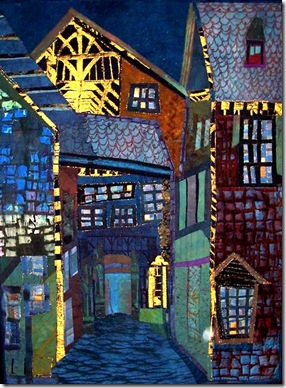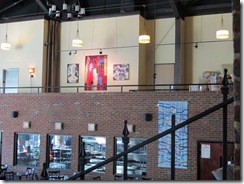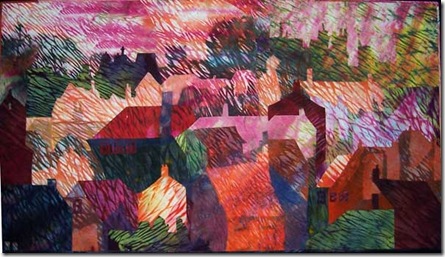 Back home from my travels and wondering how on earth anyone can ever convey the majesty and breadth of the natural undisturbed landscape in their art! We stayed on an island where the inhabitants have voted against advertising, chain and discount stores; it’s a land of small farms, cottages and masses of wild flowers. Nothing better! Flowers taking over the road rather than trash and traffic! We took the ferry to a land of magic: Manitoulin Island, Ontario, Canada
Back home from my travels and wondering how on earth anyone can ever convey the majesty and breadth of the natural undisturbed landscape in their art! We stayed on an island where the inhabitants have voted against advertising, chain and discount stores; it’s a land of small farms, cottages and masses of wild flowers. Nothing better! Flowers taking over the road rather than trash and traffic! We took the ferry to a land of magic: Manitoulin Island, Ontario, Canada


Whilst away I read several books on creativity. For the most part these involve the same anecdotes (the amazing discovery of post- it notes and so on) about inventions for profit and somewhat wordy and domesticated discussions of a few psychological experiments here and there. I don’t really recommend any of the books; however, there are a few interesting conclusions.
Persistence.
Time and time again people say to me “oh it must be wonderful to be so talented!”. It’s a load of rubbish! there may be a few born geniuses out there, but 99.9% of “creative people were not born with any special talents. And I definitely wasn’t. I am, however, persistent (as many have complained over the years! in fact, a lot more than have wondered at my talent!) and one of the statements I’ve seen over and over in the books and articles about creativity is that the ability to persist at a task is one of the most important predictors of success.
Risk taking
We need to be able to allow ourselves to fail, and if we really want to make great work then “Fail Big!” If we limit ourselves to the safe and true, to always following the rules, we won’t create anything innovative at all.
Sharing of ideas
I hate the secrecy that now permeates the business world, the science world and the art world. If we share and build upon each other’s ideas we will create more work, discover more things, find more answers, develop more amazing ideas. Even quilt shows have now bought into the for profit world’s secrecy requirements.
This way of thinking has considerably limited scientific discovery too. Everyone is fighting for a grant so don’t share your data because it might be your only chance at getting a grant for your lab. And whatever you do, don’t let anyone see the quilt you might enter the next big international quilt show! God forbid – they might make a better one based on the same idea!
The sharing of knowledge (rather than the greedy hoarding that is rampant when profits are paramount) is what moves the frontiers of knowledge forward – no matter the medium.
Constructive criticism
Being told everything you make is wonderful does not help you to grow as an artist. Nor does it help children in schools to be given all As for even the most shoddy and shallow work. When I worked at a university, many freshmen were absolutely stunned that they might need to study to gain an A, why…they’d never studied before! Alas in art work constructive criticism is one of the hardest things to get. And that’s why I spend some time on it in my real life and virtual workshops. It is difficult to know if you’re making progress if an external eye is not available for feedback (preferably two!).
Ability to “steal” without risk of a lawsuit
Apparently there are lawyers out there who buy up big groups of patents and then troll through looking for those who may have advertently or inadvertently broken copyright. Don’t you dare include That Mouse in your quilt! or even the Bear of very Little BRain.
And yet, many great artists have honed their craft by building on other artist’s work: amongst these being William Shakespeare who began writing his plays using Christopher Marlowe’s techniques and basing his plots on published stories! Bob Dylan also built his songs upon existing ones. Neither Bill nor Bob could get away with it today, those trolling lawsuit bringing lawyers would be right down on them! Borrowing is not very helpful, you don’t grow that way…but “stealing” i.e. making an idea your own and developing it further and further is a time honoured system. Somebody once told me that I shouldn’t make black and white quilts because a Famous Teacher used black and white in her teaching examples i.e. that teacher now “owned” that color scheme!!! What limitations we do put upon ourselves!
A culture that supports rather than represses innovation
Alas many of our current educational practices repress. I remember being surprised at the amount of facts I was supposed to rote learn (and, moreover, categories of facts!) when I first went to a U.S. university. Facts can be looked up (especially these days), thinking, however, has to be honed.
Furthermore, limiting good education to the well endowed few limits us all.
Time to explore process
We need time to explore processes, instead of just being lectured about them or being pressed to produce something. We need to play!
A people mix
Research show that when people from different cultures mix together, exciting things happen in all fields; let us not barricade ourselves into our homogenous little groups – heterogeneity rules when it comes to creativity!
So, now I’ve saved you from reading all those books, go off and Make Work!! And, if you have a few minutes, be sure to send in your comments. A blog without comments is a tomato without salt!
And, if you have been, thanks for reading! Elizabeth
very little brain but you knw
 I’ve written a couple of books, mostly centered on my own creative processes, which are going through the lengthy editing process so necessary for polishing!
I’ve written a couple of books, mostly centered on my own creative processes, which are going through the lengthy editing process so necessary for polishing!





















